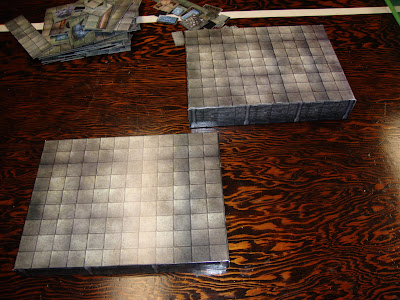"The earth belongs to the living, not the dead." - Thomas Jefferson
Today I'll be talking about the last of the elements, earth. I wrote about the first three (water, air and fire), took a little bit of a break, and am now back to finish up the series I had started. And so, it's time to talk about earth.
Earth has long been my favorite element, as I like plants and nature. However, earth can also describe the rock formations and dirt, etc. And so, there are many topics to discuss when it comes to the element of earth.
The most obvious thing, in my opinion, to do for earth is to create an earthquake in the middle of a battle. The players confront the big enemy, until their foe casts a hugely powerful spell which creates a huge rift in the middle of the battlefield. This is a game changer, but it's not crazy enough for me.
And so, enter the Dungeon Tiles. This is my favorite set to use for pictures in the blog, and it's also the set that I have the most experience building with. The squares stand out in the pictures, making it easier to get my point across.
A picture is worth 1,000 words, so I present you the Dungeon Tiles Master Set: The Dungeon.
If we slide off the slip case, we see an interesting box that is covered with dungeon squares.
And, if we empty the box of its contents, we gain two large platforms.
In order to use 3-D terrain, it is important to know how tall it is, for the sake of climbing, movement and falling. I simply take a regular dungeon tile and line it up, counting the squares.
Once I get an idea for how tall all the various pieces are, it's time to get to work.
My idea for an epic "earth elemental" themed battlefield is to creating roiling terrain. Parts of the battlefield will rise and fall, stranding some characters on platforms, lest they risk jumping off or climbing down. Throw an earthquake into the mix, and you have a crazy battle that jumps all over. I suggest making a random effect chart that you roll for at the end of each round to create an effect. Rolling 1d10 gives you enough possibilities to have enough interesting effects.
1. A 20 foot tall pillar erupts from the ground
2. Earthquake! - A 10 foot gap appears in the middle of the map.
3. A 20 x 20 platform that's 10 feet high erupts.
4. Place another 3D tile on top of another pillar.
5. A pit opens up in the ground.
6. A pit closes.
7. A pillar falls back into the ground.
8. The map comes back together if it had broken apart by an earthquake.
9. A 10 foot high platform rises from the ground.
10. The earth shakes, sliding all characters 1d4 squares in the direction of your choice.
While this list might need a little tweaking, it adds enough chaos to make it feel like the earth is truly alive. My advice for monsters are ones with earthwalk and burrowing speeds, as they can burrow through the pillars and below them, moving across the battlefield at ease. Climb speeds are always useful as well.
Below, I've taken some pictures to give some visuals of things that can be done.
 |
| Start of battle. Spider on raised floor. |
 |
| Main floor raises as the earth roils. |
 |
| Pillars of earth erupt from the ground, changing the battlefield dramatically. |
I hope this inspires you to create your own crazy earth elemental encounters. Good luck!





Comments
Post a Comment